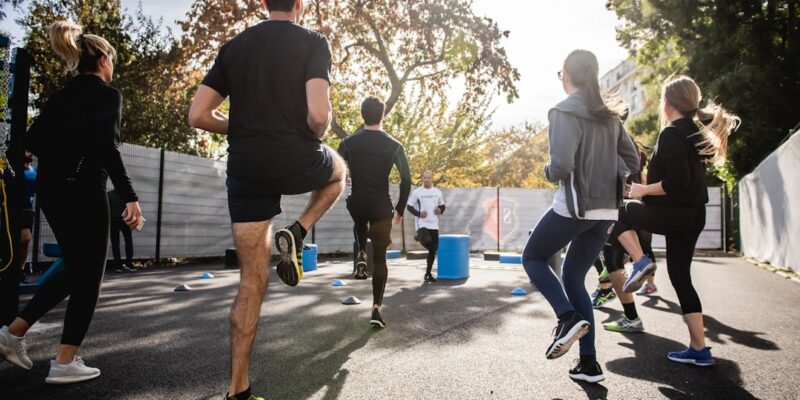
Joint-Friendly Workouts: Low-Impact Exercises for Optimal Health
Joint health is crucial for overall well-being and mobility. Our joints are responsible for connecting our bones and allowing us to move freely. However, as we age or engage in high-impact activities, our joints can become worn down and susceptible to injury. This is why it is important to incorporate joint-friendly workouts into our fitness routines.
Joint-friendly workouts are exercises that minimize stress on the joints while still providing a challenging workout. These workouts are designed to protect the joints from excessive impact and strain, reducing the risk of injury and promoting long-term joint health. By incorporating joint-friendly workouts into our fitness routines, we can maintain healthy joints and continue to enjoy an active lifestyle.
Key Takeaways
- Low-impact exercises are beneficial for joint health and can reduce the risk of injury.
- Joint-friendly workouts include swimming, cycling, yoga, Pilates, and walking.
- High-impact exercises can be modified to be joint-friendly by reducing the intensity or using equipment.
- Creating a joint-friendly workout routine involves incorporating a variety of exercises and listening to your body.
- Stretching is important for joint health and injury prevention, and should be included in any workout routine.
Benefits of Low-Impact Exercises for Joint Health
Low-impact exercises are a key component of joint-friendly workouts. These exercises involve minimal force on the joints, making them ideal for individuals with joint pain or conditions such as arthritis. Some examples of low-impact exercises include swimming, cycling, walking, and using an elliptical machine.
One of the main benefits of low-impact exercises is that they help to strengthen the muscles around the joints without putting excessive stress on them. This can help to improve joint stability and reduce pain. Additionally, low-impact exercises can improve cardiovascular health, increase flexibility, and promote weight loss, all of which contribute to overall joint health.
Top 5 Joint-Friendly Workouts for Optimal Health
1. Swimming: Swimming is a highly effective joint-friendly workout that provides a full-body workout without putting stress on the joints. The buoyancy of the water helps to support the body, reducing impact on the joints while still providing resistance for muscle strengthening. Swimming also improves cardiovascular fitness and flexibility.
2. Yoga: Yoga is a low-impact exercise that focuses on strength, flexibility, and balance. It involves gentle movements and poses that can be modified to suit individual needs. Yoga helps to improve joint flexibility, reduce stiffness, and increase muscle strength, all of which contribute to better joint health.
3. Pilates: Pilates is a low-impact exercise that focuses on core strength, flexibility, and body awareness. It involves controlled movements and exercises that target the deep muscles of the abdomen and back. Pilates helps to improve posture, balance, and joint stability, making it an excellent choice for joint-friendly workouts.
4. Cycling: Cycling is a low-impact exercise that can be done indoors on a stationary bike or outdoors on a regular bike. It provides a cardiovascular workout while minimizing stress on the joints. Cycling helps to improve leg strength, cardiovascular fitness, and joint mobility.
5. Tai Chi: Tai Chi is a gentle martial art that involves slow, flowing movements and deep breathing. It is a low-impact exercise that improves balance, flexibility, and joint range of motion. Tai Chi also promotes relaxation and stress reduction, which can have a positive impact on joint health.
How to Modify High-Impact Exercises to Make Them Joint-Friendly
| Exercise | High-Impact Version | Joint-Friendly Modification |
|---|---|---|
| Jumping Jacks | Jumping Jacks | Step Jacks |
| Jump Squats | Jump Squats | Bodyweight Squats |
| Jump Lunges | Jump Lunges | Reverse Lunges |
| High Knees | High Knees | Marching in Place |
| Burpees | Burpees | Modified Burpees (without jump) |
High-impact exercises are activities that involve jumping or pounding movements, such as running or jumping jacks. While these exercises can provide a great cardiovascular workout, they can also put excessive stress on the joints. However, with some modifications, high-impact exercises can be made joint-friendly.
One way to modify high-impact exercises is to reduce the intensity or impact level. For example, instead of running on hard pavement, try running on a softer surface like grass or a treadmill with cushioning. This will help to absorb some of the impact and reduce stress on the joints.
Another way to modify high-impact exercises is to incorporate low-impact alternatives. For example, instead of jumping jacks, try doing side steps or marching in place. These exercises provide similar cardiovascular benefits without the excessive impact on the joints.
It is also important to listen to your body and take breaks when needed. If you start to feel pain or discomfort in your joints during a high-impact exercise, it is important to stop and rest. Pushing through the pain can lead to further injury and damage to the joints.
Tips for Creating a Joint-Friendly Workout Routine
Creating a joint-friendly workout routine involves incorporating a variety of exercises that target different muscle groups and minimize stress on the joints. Here are some tips for creating a joint-friendly workout routine:
1. Start with a warm-up: Before starting any workout, it is important to warm up the muscles and joints. This can be done through gentle stretching, light cardio exercises, or mobility exercises.
2. Incorporate low-impact exercises: As mentioned earlier, low-impact exercises are ideal for joint health. Try to include at least two to three low-impact exercises in your workout routine, such as swimming, yoga, or cycling.
3. Alternate between high-impact and low-impact exercises: If you enjoy high-impact exercises, it is still possible to include them in your routine. However, it is important to alternate between high-impact and low-impact exercises to give your joints a break.
4. Include strength training: Strength training is important for joint health as it helps to build muscle strength and support the joints. Incorporate exercises that target different muscle groups, such as squats, lunges, push-ups, and planks.
5. Don’t forget about flexibility: Flexibility exercises are crucial for joint health as they help to improve joint range of motion and reduce stiffness. Include stretching exercises in your routine, such as static stretches or dynamic stretches.
6. Progress gradually: When starting a new workout routine or trying new exercises, it is important to progress gradually. Start with lighter weights or lower intensity and gradually increase as your strength and fitness levels improve.
7. Listen to your body: Pay attention to how your body feels during and after workouts. If you experience pain or discomfort in your joints, it is important to modify or stop the exercise. Pushing through the pain can lead to further injury and damage to the joints.
The Role of Stretching in Joint Health and Injury Prevention
Stretching plays a crucial role in joint health and injury prevention. It helps to improve joint flexibility, reduce muscle tension, and increase blood flow to the muscles and joints. There are two main types of stretches: static stretches and dynamic stretches.
Static stretches involve holding a stretch for a prolonged period of time, usually around 30 seconds. These stretches help to improve joint range of motion and flexibility. Some examples of static stretches include hamstring stretches, calf stretches, and shoulder stretches.
Dynamic stretches involve moving the joints through a full range of motion in a controlled manner. These stretches help to warm up the muscles and joints before a workout, improving joint mobility and reducing the risk of injury. Some examples of dynamic stretches include arm circles, leg swings, and trunk rotations.
It is important to incorporate both static and dynamic stretches into your workout routine for optimal joint health. Stretching should be done after a warm-up and before starting any intense exercise. It is also important to stretch both sides of the body equally to maintain balance and prevent muscle imbalances.
Joint-Friendly Workouts for Specific Conditions (e.g. Arthritis, Osteoporosis)
Joint-friendly workouts can be particularly beneficial for individuals with specific conditions such as arthritis or osteoporosis. These conditions can cause joint pain, stiffness, and reduced mobility, making it important to choose exercises that minimize stress on the joints.
For individuals with arthritis, low-impact exercises such as swimming, yoga, and tai chi are highly recommended. These exercises help to improve joint flexibility, reduce pain and inflammation, and increase muscle strength. Water aerobics classes can also be beneficial as they provide resistance without putting stress on the joints.
For individuals with osteoporosis, weight-bearing exercises are important for maintaining bone density and preventing fractures. However, it is important to choose exercises that are low-impact and minimize stress on the joints. Some examples of joint-friendly weight-bearing exercises include walking, low-impact aerobics, and using resistance bands or light weights for strength training.
It is always important to consult with a healthcare professional before starting any new exercise program, especially if you have a specific condition or injury. They can provide guidance on the best exercises for your individual needs and help you create a safe and effective workout routine.
The Importance of Proper Form and Technique in Joint-Friendly Workouts
Proper form and technique are crucial in joint-friendly workouts to ensure that the exercises are performed correctly and effectively. Using proper form helps to target the intended muscles, reduce the risk of injury, and maximize the benefits of the exercise.
One of the most important aspects of proper form is maintaining good posture. This involves keeping the spine neutral, shoulders relaxed, and core engaged. It is also important to avoid excessive twisting or bending of the joints, as this can put unnecessary stress on them.
Another key aspect of proper form is using the correct range of motion. This means moving the joints through their full range of motion without forcing them beyond their limits. It is important to listen to your body and avoid any movements that cause pain or discomfort.
Proper breathing is also important during workouts. It is recommended to exhale during the exertion phase of an exercise and inhale during the relaxation phase. This helps to stabilize the core and provide oxygen to the muscles.
If you are unsure about proper form or technique, it is recommended to seek guidance from a qualified fitness professional or personal trainer. They can provide instruction and feedback to ensure that you are performing the exercises correctly and safely.
How to Listen to Your Body and Avoid Overexertion or Injury
Listening to your body is crucial in joint-friendly workouts to avoid overexertion or injury. It is important to pay attention to how your body feels during and after workouts and make adjustments as needed.
One way to listen to your body is to start slowly and gradually increase the intensity or duration of your workouts. This allows your body to adapt and prevents overexertion. It is also important to take rest days and allow your body time to recover between workouts.
If you experience pain or discomfort in your joints during a workout, it is important to stop and rest. Pushing through the pain can lead to further injury and damage to the joints. It is also important to differentiate between muscle soreness and joint pain. Muscle soreness is normal after a workout and usually resolves within a few days, while joint pain can indicate an underlying issue that needs to be addressed.
It is also important to modify exercises or choose alternative exercises if you have a pre-existing condition or injury. For example, if you have knee pain, you can modify squats by using a stability ball against a wall for support. If you have shoulder pain, you can choose exercises that target the muscles around the shoulder joint without putting stress on it.
Lastly, it is important to listen to your body’s signals of fatigue or exhaustion. If you feel tired or fatigued during a workout, it is important to take a break or stop altogether. Pushing through fatigue can increase the risk of injury and compromise your overall performance.
Incorporating Joint-Friendly Workouts for Long-Term Health and Wellness
Incorporating joint-friendly workouts into your fitness routine is crucial for long-term joint health and overall well-being. These workouts help to protect the joints from excessive impact and strain, reducing the risk of injury and promoting optimal joint function.
By choosing low-impact exercises, modifying high-impact exercises, and incorporating a variety of exercises that target different muscle groups, you can create a joint-friendly workout routine that promotes joint health and prevents injury.
Remember to listen to your body, use proper form and technique, and make adjustments as needed to avoid overexertion or injury. By taking care of your joints through joint-friendly workouts, you can enjoy an active lifestyle and maintain long-term health and wellness.
FAQs
What are low-impact exercises?
Low-impact exercises are physical activities that put minimal stress on the joints, bones, and muscles. These exercises are ideal for people who have joint pain, arthritis, or are recovering from an injury.
What are the benefits of low-impact exercises?
Low-impact exercises can help improve joint health, increase flexibility, and reduce the risk of injury. They can also help with weight management, improve cardiovascular health, and boost mood and energy levels.
What are some examples of low-impact exercises?
Examples of low-impact exercises include walking, cycling, swimming, yoga, Pilates, and water aerobics. These exercises are gentle on the joints and can be modified to suit different fitness levels.
Can low-impact exercises help with joint pain?
Yes, low-impact exercises can help reduce joint pain and stiffness. They can also improve joint mobility and flexibility. However, it is important to consult with a healthcare professional before starting any exercise program, especially if you have a pre-existing medical condition.
Are low-impact exercises suitable for everyone?
Low-impact exercises are generally safe and suitable for most people, including seniors, pregnant women, and those with joint pain or arthritis. However, it is important to start slowly and gradually increase the intensity and duration of the exercise. It is also important to listen to your body and stop if you experience any pain or discomfort.


















